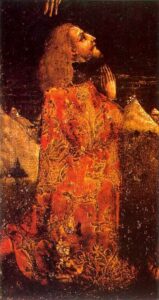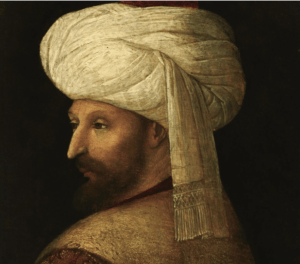
The First to Accept the Storm
First Jelena Branković lost her father.
Then before four months could pass, in 1459 at the age of 11, she was married to the son of the King of Bosnia. Stjepan Tomasević had not even met Jelena, but they were married on 1 April 1459. Given that Tomasević had been casting around the Balkans for a suitable rich bride for the previous few years, the reasons the 21-year-old prince had for marrying the pre-teen daughter of the dead Despot of Serbia had nothing to do with love in any form.

So Jelena’s despotate, which could not pass to a girl, even if that girl was the daughter of the despot, was passed to her new husband.
Her new husband also required her to change her religion from Orthodox to Catholic. Jelena was not even able to keep her name: she became Marija.
And on 21 June the new Marija’s husband lost the fortress of Smederevo to an Ottoman incursion, holding it for only three months before fleeing back to his father’s court in Bosnia. Marija also lost her country.
There is no record left of how the child felt about this upheaval. The relentless Ottoman advance across the Balkans had been a defining feature of her childhood, so perhaps she knew what was coming.
As well, her Aunt Mara Branković had been married off to Sultan Murad II in an attempt to forestall an Ottoman invasion of Serbia. Marija grew up knowing her aunt, who returned to the Serbian court on Murad’s death in 1451 and then departed for an Ottoman estate in Ježevo (modern Greece). There’s no reason to believe Marija didn’t understand exactly what her duty was and why although the fact that her Aunt Mara continued to advise her step-son Mehmed the Conqueror had to cause some uncomfortable moments in the family.
Still, Marija lost her parents, religion, name, and country before she turned 12-years-old. The experience had to scar her.
And then she lived at the court of her in-laws for two years until her father-in-law’s death and her husband’s ascent to the Bosnian throne.

No records remain of what Marija’s life was like in Bosnia. We don’t know if she got along with her husband or her in-laws. We don’t know if she made friends, or what she enjoyed. We don’t know if she and Stjepan Tomasević lived as husband and wife, although we do know that they did not have any children.
The next time we see Marija in the historical record is after her husband has become the King of Bosnia, and just like Smederevo, in 1463 she is running to escape the Ottomans.
Bosnia remained the last bulwark between the Ottomans and Hungary after the fall of Smederevo, and Stjepan Tomasević begged the rulers of the Christian countries surrounding him, as well as the Pope, for help in defense. In one letter to Pope Pius, Stjepan Tomasević ranted, “I am the first to expect the storm. My father predicted to your predecessor, Nicholas V, and the Venetians the fall of Constantinople. He was not believed. […] Now I prophesy about myself. If you trust and aid me I shall be saved; if not I shall perish and many shall be ruined with me.“
Hoping still that aid would appear as promised, in 1462 Stjepan Tomasević created a situation of no return – calling the Ottoman ambassador to him, he showed the ambassador the gold that was supposed to be used for tribute payments. Then the Bosnian King refused to give the Ottomans the gold, saying he would rather use it for an army to fight or to live in exile. If anyone asked Marija how she felt about any of this, no one thought to write down her answer.
The infuriated Sultan, Mehmed the Conqueror, focused on Bosnia – riding into the country in spring 1463. None of Stjepan Tomasević’s promised aid appeared. He realized he was doomed.
Marija was sent, along with the family treasure, to Dalmatia. Separated from her step-mother-in-law Katerina and Katerina’s two children, Marija managed to make it to safety. In the course of her flight, however, she lost the precious relics that had been entrusted to her keeping.
Meanwhile, the royal Bosnian fortress of Bobovac fell to the Ottomans after only four days. The King fled, attempting to reach Dalmatia with his wife, but was betrayed and handed over to the Ottomans near Ključ. After being promised safety, on 25 May 1463 he was beheaded.

Within four years Marija of Serbia, the Queen of Bosnia, lost her parents, her despotate, her religion, her name, her nation, her family relics, and now her husband.
Within the year, her meetings with Bosnians and Hungarians began to offend the Venetians with whom she had taken refuge, and Marija lost yet another home.
This time she headed to the Ježevo court of her Aunt Mara, but that didn’t last further than the early 1470s when Marija had her Aunt Katarina Branković arrested.
This time Marija lost two aunts and a fourth home. She headed to Constantinople where she was welcomed and supported by the Sultan.
The reason for Marija’s welcome by the Sultan are lost to history, but Marija appears a few more times – each time is in the framework of suing a religious institution, often being aided by the Sultan himself. Marija’s lawsuits were so targeted and so vicious that her final epitaph, before her death sometime around 1500, was when monks on Mount Athos referred to her as an “evil woman.“
By the time Marija died she had lost her parents, her despotate, her name, three countries, four homes, her relics, her husband, her aunts, and – it seems likely – two religions. A forensic psychiatrist could probably explain Marija’s never-ending stream of lawsuits better than a historian.
For more about the history of Bosnia and Herzegovina, please click here.
- April 28, 2021
- History
